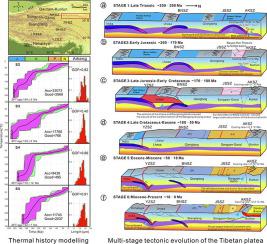当前位置:
X-MOL 学术
›
J. Asian Earth Sci.
›
论文详情
Our official English website, www.x-mol.net, welcomes your
feedback! (Note: you will need to create a separate account there.)
Multi-stage tectonic events of the Eastern Kunlun Mountains, Northern Tibetan Plateau constrained by fission track thermochronology
Journal of Asian Earth Sciences ( IF 2.7 ) Pub Date : 2020-08-01 , DOI: 10.1016/j.jseaes.2020.104428 Pengfei Tian , Wanming Yuan , Xiaoyong Yang , Zirui Feng , Xue Chen , Erjun Yuan
Journal of Asian Earth Sciences ( IF 2.7 ) Pub Date : 2020-08-01 , DOI: 10.1016/j.jseaes.2020.104428 Pengfei Tian , Wanming Yuan , Xiaoyong Yang , Zirui Feng , Xue Chen , Erjun Yuan

|
Abstract The present Tibetan plateau is a collage of several terranes, including the Lhasa, Qiangtang, Songpan-Ganzi and Kunlun-Qaidam terranes. Following closure of the Palaeo- and Neo-Tethyan oceans, the terranes of the Tibetan plateau migrated northward, and the deformation timing of the northern part of the Songpan-Ganze terrane between Golmud and Dulan in the Eastern Kunlun Orogenic Belt (EKOB) is still poorly understood. Fission track (FT) analysis of zircon and apatite from two localities between Golmud and Dulan has yielded new information about the timing of deformation in EKOB. Samples collected from Aikeng and Boguole yielded zircon and apatite FT central age ranges of ~193–133 Ma and ~103–29 Ma respectively. Thermal history modelling of FT data revealed five major episodes of cooling in these regions at ~200–170 Ma, ~170–100 Ma, ~100–50 Ma, ~50–18 Ma, and ~18–0 Ma. Stage one represents the collision between the Qiangtang and Kunlun tectonic blocks and the closure of the Songpan-Ganzi-Bayan Har Triassic turbidite basin. In stage two, the northward subduction of the Neo-Tethys oceanic plate accentuated sediment transport to the actively closing ocean basin between the Lhasa and Qiangtang terranes, the far-field effect of collision caused the cooling of the EKOB. Stage three is characterised by tectonic quiescence, which ended at ~50 Ma due to the collision of India and Asia. In stage four, the establishment of a strike-slip fault system and fold-thrust belt in the EKOB resulted in exhumation. Stage five saw rapid cooling in response to the most recent compressional event associated with fault development in the EKOB.
中文翻译:

受裂变径迹热年代学约束的青藏高原东昆仑多期构造事件
摘要 目前青藏高原是拉萨、羌塘、松潘-甘孜、昆仑-柴达木等多地体的拼贴。古、新特提斯洋闭合后,青藏高原地体向北迁移,东昆仑造山带(EKOB)格尔木至都兰之间松潘-甘孜地体北部的变形时间尚待确定。不太了解。对格尔木和都兰之间两个地区的锆石和磷灰石的裂变径迹 (FT) 分析产生了关于 EKOB 变形时间的新信息。从艾坑和博果乐采集的样品产生的锆石和磷灰石 FT 中心年龄范围分别为~193-133 Ma 和~103-29 Ma。FT 数据的热历史模型揭示了这些区域在 ~200-170 Ma、~170-100 Ma、~100–50 Ma、 ~50–18 Ma 和 ~18–0 Ma。第一阶段代表羌塘和昆仑构造块的碰撞和松潘-甘孜-巴彦哈尔三叠系浊积盆地的闭合。第二阶段,新特提斯洋板块向北俯冲,加剧了拉萨和羌塘地体之间向闭合洋盆的沉积物输送,碰撞的远场效应导致EKOB变冷。第三阶段的特点是构造静止,由于印度和亚洲的碰撞,它在~50 Ma 结束。在第四阶段,EKOB 走滑断层系统和褶皱冲断带的建立导致了折返。第五阶段见证了与 EKOB 断层发展相关的最新压缩事件的快速冷却。第一阶段代表羌塘和昆仑构造块的碰撞和松潘-甘孜-巴彦哈尔三叠系浊积盆地的闭合。第二阶段,新特提斯洋板块向北俯冲,加剧了拉萨和羌塘地体之间向闭合洋盆的沉积物输送,碰撞的远场效应导致EKOB变冷。第三阶段的特点是构造静止,由于印度和亚洲的碰撞,它在~50 Ma 结束。在第四阶段,EKOB 走滑断层系统和褶皱冲断带的建立导致了折返。第五阶段见证了与 EKOB 断层发展相关的最新压缩事件的快速冷却。第一阶段代表羌塘和昆仑构造块的碰撞和松潘-甘孜-巴彦哈尔三叠系浊积盆地的闭合。第二阶段,新特提斯洋板块向北俯冲,加剧了拉萨和羌塘地体之间向闭合洋盆的沉积物输送,碰撞的远场效应导致EKOB变冷。第三阶段的特点是构造静止,由于印度和亚洲的碰撞,它在~50 Ma 结束。在第四阶段,EKOB 走滑断层系统和褶皱冲断带的建立导致了折返。第五阶段见证了与 EKOB 断层发展相关的最新压缩事件的快速冷却。
更新日期:2020-08-01
中文翻译:

受裂变径迹热年代学约束的青藏高原东昆仑多期构造事件
摘要 目前青藏高原是拉萨、羌塘、松潘-甘孜、昆仑-柴达木等多地体的拼贴。古、新特提斯洋闭合后,青藏高原地体向北迁移,东昆仑造山带(EKOB)格尔木至都兰之间松潘-甘孜地体北部的变形时间尚待确定。不太了解。对格尔木和都兰之间两个地区的锆石和磷灰石的裂变径迹 (FT) 分析产生了关于 EKOB 变形时间的新信息。从艾坑和博果乐采集的样品产生的锆石和磷灰石 FT 中心年龄范围分别为~193-133 Ma 和~103-29 Ma。FT 数据的热历史模型揭示了这些区域在 ~200-170 Ma、~170-100 Ma、~100–50 Ma、 ~50–18 Ma 和 ~18–0 Ma。第一阶段代表羌塘和昆仑构造块的碰撞和松潘-甘孜-巴彦哈尔三叠系浊积盆地的闭合。第二阶段,新特提斯洋板块向北俯冲,加剧了拉萨和羌塘地体之间向闭合洋盆的沉积物输送,碰撞的远场效应导致EKOB变冷。第三阶段的特点是构造静止,由于印度和亚洲的碰撞,它在~50 Ma 结束。在第四阶段,EKOB 走滑断层系统和褶皱冲断带的建立导致了折返。第五阶段见证了与 EKOB 断层发展相关的最新压缩事件的快速冷却。第一阶段代表羌塘和昆仑构造块的碰撞和松潘-甘孜-巴彦哈尔三叠系浊积盆地的闭合。第二阶段,新特提斯洋板块向北俯冲,加剧了拉萨和羌塘地体之间向闭合洋盆的沉积物输送,碰撞的远场效应导致EKOB变冷。第三阶段的特点是构造静止,由于印度和亚洲的碰撞,它在~50 Ma 结束。在第四阶段,EKOB 走滑断层系统和褶皱冲断带的建立导致了折返。第五阶段见证了与 EKOB 断层发展相关的最新压缩事件的快速冷却。第一阶段代表羌塘和昆仑构造块的碰撞和松潘-甘孜-巴彦哈尔三叠系浊积盆地的闭合。第二阶段,新特提斯洋板块向北俯冲,加剧了拉萨和羌塘地体之间向闭合洋盆的沉积物输送,碰撞的远场效应导致EKOB变冷。第三阶段的特点是构造静止,由于印度和亚洲的碰撞,它在~50 Ma 结束。在第四阶段,EKOB 走滑断层系统和褶皱冲断带的建立导致了折返。第五阶段见证了与 EKOB 断层发展相关的最新压缩事件的快速冷却。











































 京公网安备 11010802027423号
京公网安备 11010802027423号